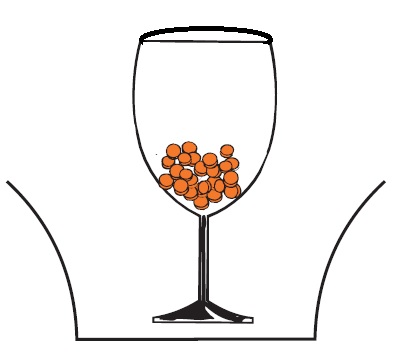This discrepant event is based on the surface tension of water. Students predict the number of pennies that can fit into a wine glass filled almost to the brim with water and then have their prediction tested.
Part 1. Teacher Demonstration.
Materials:
- wine glass

- large plastic tub
- food colouring (optional)
- 100 pennies
Procedure:
- Place a wine glass in the centre of a large plastic tub.
- Fill the wine glass to within about 0.2 cm of its rim with coloured tap water.
- Ask students to predict how many pennies can be added to the wine glass without water overflowing.
- Ask one student to carefully add pennies edge first, one at a time, until water begins to overflow. Count the number of pennies added.
Part 2: Student Activity
Materials (per pair of students):
- penny
- liquid soap
- plastic Petri dish
- plastic dropper
- plastic cup
Procedure
- Place the penny in the Petri dish.
- Predict how many drops of water will fit on the penny without overflowing. Identify factors that could influence the number of drops that can fit.
- Add 1–2 drops of liquid soap into the plastic cup of water and mix well.
- Predict what effect the addition of soap might have on your observation in step 2.
- Test your prediction by repeating the activity using soapy water.
What happens?
Part 1. Teacher Demonstration.
Most students underestimate the number of pennies than can be added to the wine glass. Careful examination of the wine glass when water begins to overflow shows that the surface of the water is stretched above the rim of the glass.
Part 2. Student Activity
Fewer drops of soapy water fit on the penny. Furthermore, the height of the soapy water bead observed on the penny is lower than when fresh tap water is used.
How Does it Work?
Due to surface tension, water forms a domed bead both on a penny and in the wine gas. This permits more pennies to be added to the wine glass than anticipated. It also permits more drops of water to be added to the surface of the penny. Surface tension is caused by the attractive forces between water molecules at the surface and between water molecules on the surface and water molecules just below the surface. Factors that determine the number of drops that fit on penny include:
- the type of penny (e.g., Canadian, American)
- the way that they land — heads or tails
- condition of the surface (e.g., corroded, etc.)
Teaching Suggestions:
This is a fun activity for the first or second day of a new school year. It is also useful to introduce the routines you wish to establish for the distribution of materials for an activity. Consider having prizes available for the team that gets the most drops on the penny.
This activity can be used to introduce the concept of cohesive forces within liquids and surface tension.


